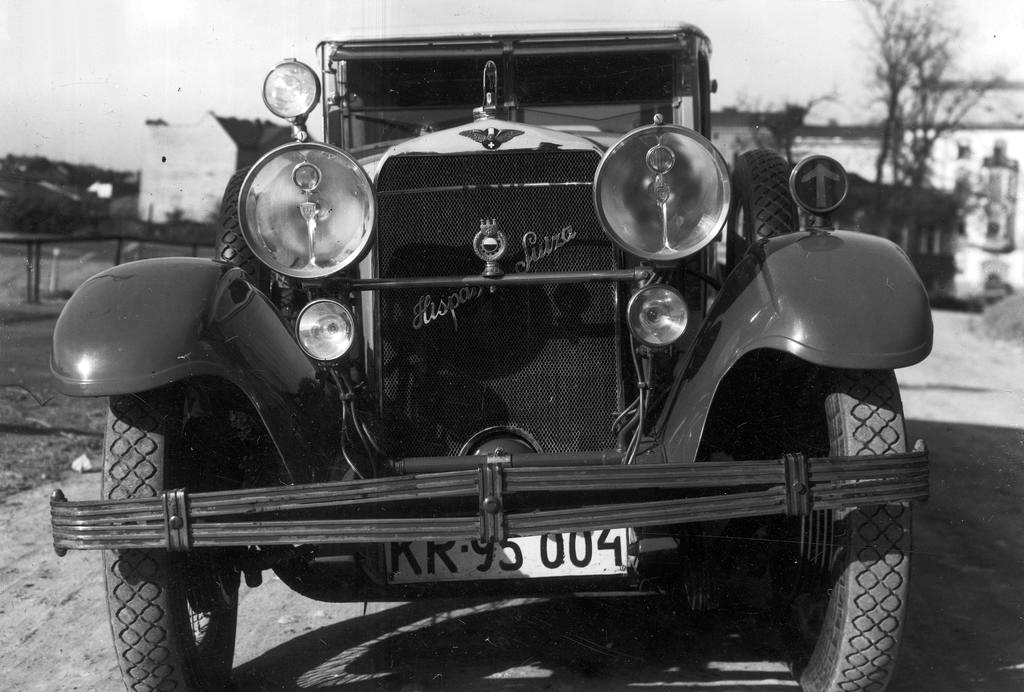M
I
C
R
O
S
T
O
R
Y
O
F
A
R
T
........................................................

NOW COMPLETED:

........................................................
MICROSTORY OF ART
ONLINE JOURNAL FOR ART, CONNOISSEURSHIP
AND CULTURAL JOURNALISM
........................................................
INDEX | PINBOARD | MICROSTORIES |
FEATURES | SPECIAL EDITIONS |
HISTORY AND THEORY OF ATTRIBUTION |
ETHNOGRAPHY OF CONNOISSEURSHIP |
SEARCH

........................................................



 >MICROSTORIES
>MICROSTORIES
- Richard Serra
- Martin Scorsese
- Claude Simon
- Sunshine
- Werner Herzog
- The Creation
- Marcel Duchamp
- Nino Rota
- Wölfflin and Woolf
- Hansjörg Schneider
- Kraftort Arkadien
- Visual Biography
- Schlaraffenleben
- Die Geisteswissenschaften
- The Voyeur
- Buzzword Sustainability
- Paul Verlaine
- Tao Yuanming
- New Beginning
- Seneca
- Still Lifes
- Charles Baudelaire
- Frédéric Chopin
- The Art History of Sustainability
- Wang Wei
- Solarpunk
- Historians of Light
- Lepanto
- Renaturalization
- Plates
- Snow in Provence
- Learning to See
- Picasso Dictionaries
- Peach Blossom Spring
- Picasso Tourism
- Tipping Points
- Sviatoslav Richter
- Weather Reports
- Treasure Hunt
- Another Snowscape in Picasso
- Picasso in 2023
- Dragon Veins
- The Gloomy Day
- The Art of the Pentimento
- Reforestation
- The Status of Painting
- Emergency Supply
- Punctuality
- Watching Traffic
- Zhong Kui
- How Painting Survived the 1990s
- Confirmation Bias
- Sustainability and Luxury
- Garage Bands
- Picasso and Artificial Intelligence
- Eyes of Tomorrow
- Picasso in 2023 2
- Gluing Oneself to Something
- Suburbia
- Bamboo
- Sustainability and Carpe Diem 1
- Interviews with Bruegel
- Sustainability and Carpe Diem 2
- Coffee & Sugar
- Bamboo 2
- Picasso in 2023 3
- Sustainability and Carpe Diem 3
- Cherry Orchard
- Old Magazines
- Chance
- Nick Drake
- Harlequin
- The Smartphone & the Art Book
- Atlas Syndrome
- The Kitchen
- Atlas Syndrome 2
- Consideration
- Tori Amos
- School
- Orchard Auctioning Day
- The Hundred Years’ War
- Sócrates
- Chameleon
- Nefertiti Bust
- Picasso as a Computer
- Sunflowers
- Philemon & Baucis
- Ode to the Radio
- Childhood
- Wimmelbild
- Restitution
- Nick Drake 2
- Wishful Thinking
- Sundays
- The Independent Scholar
- September
- The Fisherman by Pirosmani
- Microadventure
- Sociology
- Salvator Mundi
- Chillon
- Appassionata
- Amber
- Homer
- Berlin
- Planet Walk
- Improvisation
- Seeing Picasso
- These Nice Kids
- Robber
- The One
- The Sea Turtle
- Zoo
- Through the Hush
- Wunderkammer
- I Do Not Seek, I Find
- Shopping Mall
- Food Hamper
- The Secretary
- This Gate
- Nor Rainy Day
- House on a Hill
- Beautiful Island
- Second-hand Bookstore
- Flat
- Slap in the Face
- Serra, Wenkenpark
- Apologies
- The Bells
- Nordmann Fir
- Picasso Wanting To Be Poor
- Picasso, Pirosmani
- A Brief History of Sculpture
- 24 Sunsets
- Rusty Phoenix
- Glove
- Wintry Stanza
- A Song
- Like A Beatle
- Catching An Orange
- Solar Bees
- Permaculture

 >FEATURES
>FEATURES
- Van Gogh On Connoisseurship
- Two Museum’s Men
- Ende Pintrix and the City in Flames
- Titian, Leonardo and the Blue Hour
- The Man with the Golden Helmet: a documentation
- Un Jury d’admission à l’expertise
- Learning to See in Hitler’s Munich
- Leonardo da Vinci and Switzerland
- The Blue Hour Continued
- The Blue Hour in Louis Malle
- Kafka in the Blue Hour
- Blue Matisse
- Blue Hours of Hamburg and LA
- A Brief History of the Cranberry
- The Other Liberale in the House
- The Blue Hour in Raphael
- Who Did Invent the Blue Hour?
- Monet on Sustainability
- Velázquez and Sustainability
- The Blue Hour in Guillaume Apollinaire
- Van Gogh on Sustainability
- The Blue Hour in Marcel Proust
- Picasso and Sustainability
- The Contemporary Blue Hour
- The Blue Hour in 1492
- The Blue Hour in Hopper and Rothko
- Hopper and Sustainability
- The Blue Hour in Ecotopia
- The Hour Blue in Joan Mitchell
- Explaining the Twilight
- The Twilight of Thaw
- The Blue Hour in Pierre Bonnard
- Explaining the Twilight 2
- Picasso on Stalin
- Rubens on Sustainability
- The Salvator Mundi in Bruegel and Rubens
- The Blue Hour in Leonardo da Vinci and Poussin
- The Blue Hour in Rimbaud
- Faking the Dawn
- Frost and Thaw in Ilya Ehrenburg
- Picasso, Stalin, Beria
- Picasso, Solzhenitsyn and the Gulag
- Shostakovich on Picasso
- Hélène Parmelin in 1956
- Historians of Picasso Blue
- Picasso Travelling to Moscow 1
- The Blue Hour in Caravaggio
- Picasso Travelling to Moscow 2
- Picasso, the Knife Game and the Unsettling in Art
- Some Notes on Leonardo da Vinci and Slavery
- Picasso Moving to the Swiss Goldcoast
- The Blue Hour in Camus
- The Blue Hour in Symbolism and Surrealism
- Caspar David Friedrich in His Element
- Exhibiting the Northern Light
- Caspar David Friedrich in His Element 2
- Robert Schumann and the History of the Nocturne
- The Blue Hour in Robert Schumann
- Caspar David Friedrich and Sustainability
- The Twilight of Thaw 2
- Multicultural Twilight
- The Blue Hour in Anton Chekhov
- The Blue Hour in Medieval Art
- Twilight Photography
- The Blue Hour in Bob Dylan
- Iconography of Optimism

 >SPECIAL EDITIONS
>SPECIAL EDITIONS
- Visions of Cosmopolis
- Mona Lisa Landscapes
- Turner and Ruskin at Rheinfelden
- Painters On TV & On TV
- Spazzacamini in Art
- A Last Glance at Le Jardin de Daubigny
- The Experimental Cicerone
- A Dictionary of Imaginary Art Historical Works
- Iconography of Blogging
- Begegnung auf dem Münsterplatz
- Cecom
- Das Projekt Visual Apprenticeship
- Those Who See More
- A Fox on Seeing with the Heart
- Sammlung Werner Weisbach
- Daubigny Revisited
- Some Salvator Mundi Microstories
- Some Salvator Mundi Afterthougths
- Some Salvator Mundi Variations
- Some Salvator Mundi Revisions
- A Salvator Mundi Questionnaire
- A Salvator Mundi Puzzle
- Unknown Melzi
- Francis I and the Crown of Charlemagne
- From Amboise to Fontainebleau
- Drones Above Chambord
- Looking Back At Conques
- Flaubert At Fontainebleau
- Images of Imperial Ideology
- The Chronicles of Santa Maria delle Grazie
- Seeing Right Through Someone
- Melzi the Secretary
- Eying Glass
- A Foil to the Mona Lisa
- A Renaissance of the Cartoon
- Sketching a Family Tree
- Venetian Variations
- A Brief History of Digital Restoring
- A Consortium of Painters
- Leonardeschi and Landscape
- A Christ in Profile
- Learning to See in Spanish Milan
- A History of Gestures
- Leonardo and Josquin
- A Renaissance of the Hybrid
- Suida and Heydenreich
- The Watershed
- Three Veils
- From Beginning to End
- Connoisseurship of AI
- Twilight and Enlightenment
- The Blue Hour in Chinese Painting
- Dusk and Dawn at La Californie
- Iconography of Sustainability
- The Blue Hour in Goethe and Stendhal
- The Sky in Verlaine
- The Blue Hour in Paul Klee
- Iconography of Sustainability 2
- The Blue Hour in Charles Baudelaire
- From Bruegel to Solarpunk
- Some Salvator Mundi Documentaries
- Some More Salvator Mundi Monkey Business
- The Windsor Sleeve
- Brigitte Bardot’s Encounter with Picasso
- Art Historians and Historians
- A Salvator Mundi Chronicle
- The Salvator Mundi and the French Revolution
- The Fontainebleau Group
- The Encounter of Harry Truman with Pablo Picasso
- The Fontainebleau Group Continued
- The Windsor Sleeve Continued
- The Salvator Mundi in Early Netherlandish Painting 1
- Some Salvator Mundi Resources
- A New Salvator Mundi Questionnaire
- The Woman in Picasso
- The Yarborough Group
- Melzi, Figino and the Mona Lisa
- The Yarborough Group Continued
- A Salvator Mundi Global History
- The Salvator Mundi in Medieval Art
- The Salvator Mundi in Medieval Art 2
- The Salvator Mundi in Early Netherlandish Painting 2


 >HISTORY AND THEORY OF ATTRIBUTION
>HISTORY AND THEORY OF ATTRIBUTION
- The Mysterious »Donna Laura Minghetti-Leonardo«
- Assorted Demons of Connoisseurship
- Panofsky Meets Morelli
- Discovering the Eye of Sherlock Holmes
- Handling the Left-handed Hatchings Argument
- Visual History of Connoisseurship
- Alexander Perrig
- Connoisseurship in 2666
- What Postmodernity Has Done to Connoisseurship
- Dividing Four Fab Hands
- A Leonardesque Ambassador
- Test Cases in Connoisseurship
- A Raphael Expertise
- How to Tell Titian from Giorgione
- Louise Richter
- The Unique Property in the History of Connoisseurship
- An Expertise by Berenson
- The Book of Expertises
- An Album of Expertises
- An Expertise by Friedländer
- A Salvator Mundi Provenance
- How to Tell Leonardo from Luini
- An Expertise by Crowe and Cavalcaselle
- An Expertise by Bayersdorfer
- An Expertise by Hermann Voss
- An Expertise by Hofstede de Groot
- Leonardeschi Gold Rush
- An Unknown »Vermeer«
- An Expertise by Roberto Longhi
- An Expertise by Federico Zeri
- A Salvator Mundi Geography
- A Salvator Mundi Atlas
- The Bias of Superficiality
- 32 Ways of Looking at a Puzzle
- James Cahill versus Zhang Daqian
- Five Fallacies in Attribution
- On Why Art History Cannot Be Outsourced to Art Dealers
- On Why Artificial Intelligence Has No Place in Connoisseurship
- Salvator Mundi Scholarship in 2016
- Leonardo da Vinci at the Courts
- The Story of the Lost Axe
- The Last Bruegel
- A Titian Questionnaire
- On Where and Why the Salvator Mundi Authentication Did Fail
- The Problem of Deattribution

 >ETHNOGRAPHY OF CONNOISSEURSHIP
>ETHNOGRAPHY OF CONNOISSEURSHIP
MICROSTORY OF ART
ONLINE JOURNAL FOR ART, CONNOISSEURSHIP
AND CULTURAL JOURNALISM
........................................................

***
ARCHIVE AND FURTHER PROJECTS

1) PRINT


***
2) E-PRODUCTIONS


........................................................

........................................................

........................................................
FORTHCOMING:


***
3) VARIA

........................................................

........................................................

........................................................

........................................................

........................................................
***
THE GIOVANNI MORELLI MONOGRAPH

- The Giovanni Morelli Monograph
........................................................
MICROSTORY OF ART
ONLINE JOURNAL FOR ART, CONNOISSEURSHIP AND CULTURAL JOURNALISM
HOME
MICROSTORY OF ART
MICROSTORY OF ART 
ONLINE JOURNAL FOR ART, CONNOISSEURSHIP AND CULTURAL JOURNALISM

Dedicated to Watching Traffic
(9.-10.3.2023) When Pablo Picasso arrived at Basel in September of 1932, he arrived in his Hispano-Suiza automobile, which was driven by a chauffeur who was wearing white gloves. Picasso was on his way to his 1932 retrospective at Zurich, and he did stay, with his wife Olga and his son Paulo (and probably also with chauffeur Marcel Boudin) at the Hotel Les Trois Rois for one night.
It was the period when Picasso looked very bourgeois, and, as one must add, somewhat pompous, vulgar and arrogant, brief: like a newly rich, ostentaciously smoking a cigar, or like his own vulgar art dealer (if not to say: like a 1930s fascist). This is as far as looking is concerned.
Yet Picasso sounded – as far as we can know, since, at Zurich, Picasso spent some time with artist Hanns Welti, who transmitted what Picasso said –, Picasso sounded as Picasso always, or very often sounded: as someone who loved to speak half-jokingly, as someone who was thoughful, polite, open, but not too intellectual (and this very deliberately so).
What did Picasso do at Basel? He did very little, but something that, much later, he recalled: from the terrace of the hotel he watched the river Rhine, and he did watch the tramways, brief: he watched the traffic. And perhaps he recalled that much later, because he had stayed up all night, after watching the tramways into the night, to see the tramways reappear at dawn. Thus we might say that Picasso witnessed a blue hour at Basel, and that he showed, and this also much later, as someone who was enjoying watching traffic. Which is, thus, the subject of our new visual essay.
1) Watching Traffic – Picasso at Basel (1932)
One might say that Picasso, from his room at the Hotel Les Trois Rois (see picture of the front of the hotel looking to the Rhine; on the left), had at least a two-bridges view, as far as the traffic of tramways was concerned. Tramways, in 1932, were apparently passing via the Mittlere Brücke, the central bridge, and the Johanniterbrücke. So Picasso could look to the right, as we imagine, from his room, or from the hotel terrace, towards the Mittlere Brücke, as well as to the left, towards the Johanniterbrücke, to see tramways move, tramways that for 21st century eyes, look very tiny, almost reminding model railways. And Picasso was obviously fascinated by, and he was enjoying the rhythm of tramways, while he was also, and at the same time, looking at the river flowing. This continuous flow must have, on some level, interacted with the continuous, but interrupted rhythm of tramways passing. And one can easily imagine that both rhythms combined might have had a meditative effect on the artist, who showed motivated (or at least said so, since, perhaps, there were other reasons) to stay up all night.
We can show pictures of period tramways here, a postcard, which, however, is somewhat earlier (c. 1910), but shows a tramway on the Mittlere Brücke and shows what Picasso would have seen, if from the other side of the bridge, from the hotel terrace, if he, then, had had a camera with a zoom. And we have found an aerial view which shows the whole topographical situation, because on the right margin of the picture (below), we can see the hotel front (compare with the picture on the left), and we also see the Mittlere Brücke, with just a tiny tramway passing. So that we can easily imagine Picasso being there and looking at the bridge with the tramway, while we are looking on the whole situation from a plane.

(Picture: Postcard, c. 1910)
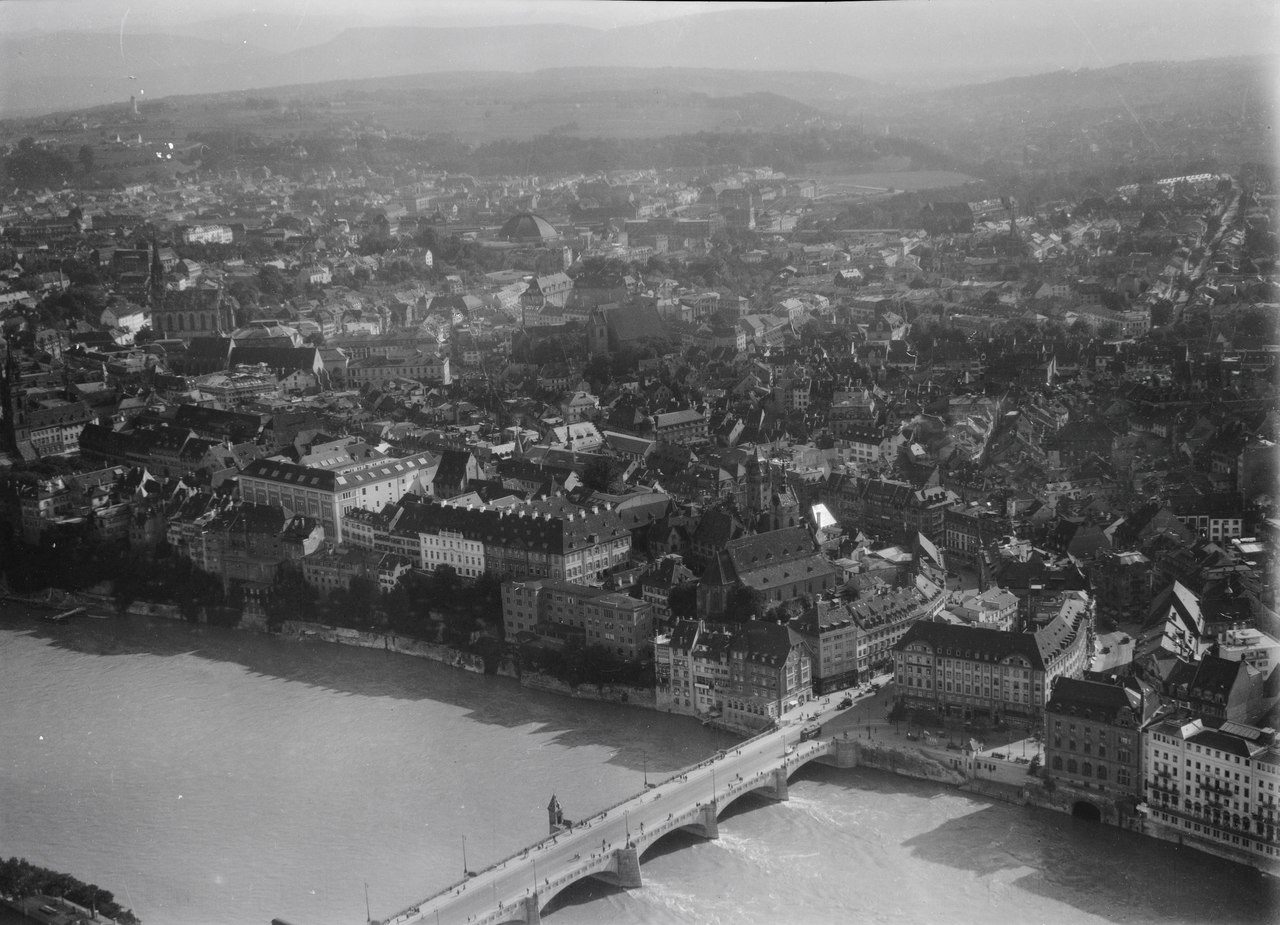
(Picture: Walter Mittelholzer; ETH-BIB-Basel)
2) Basel – 2023
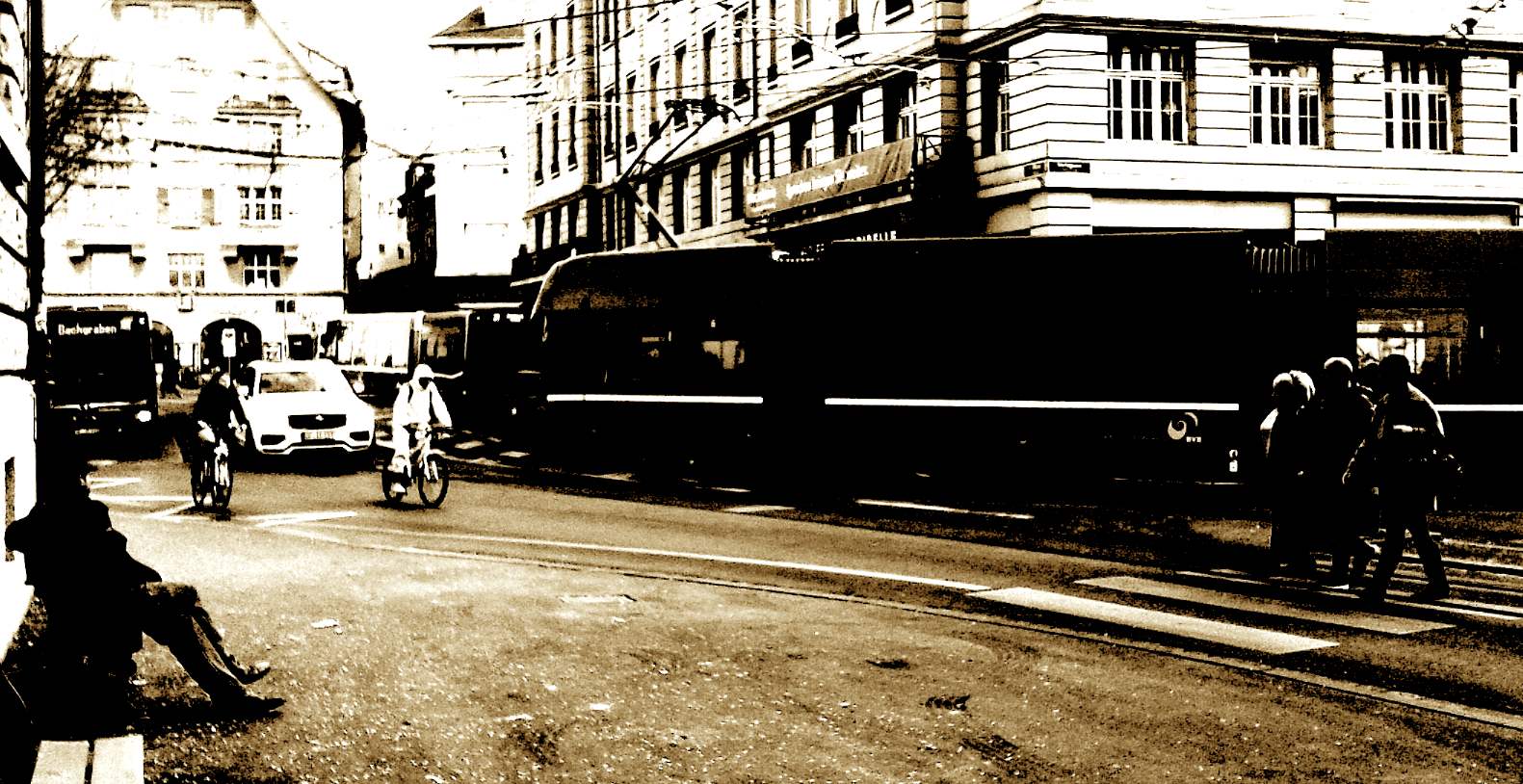
A Man Watching Traffic (picture: DS)
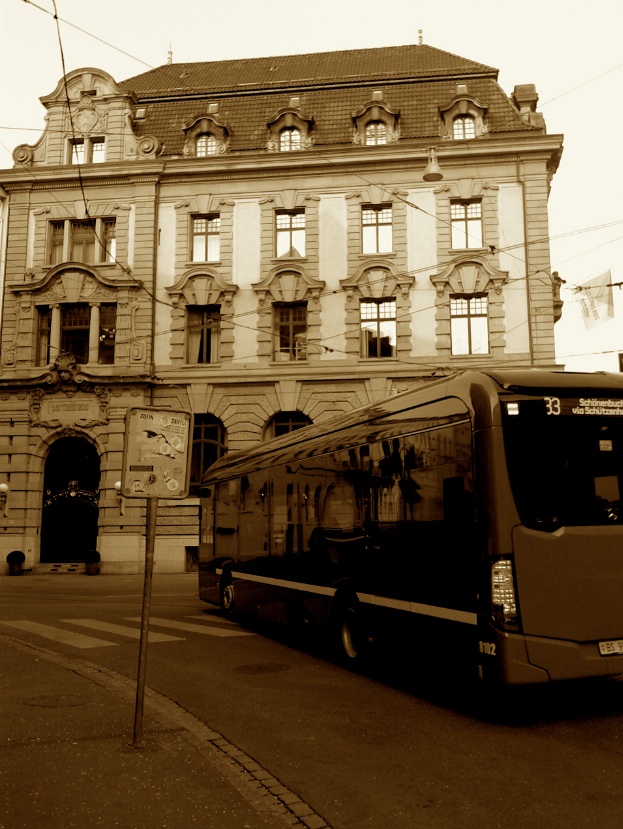
Looking Back at the Hotel (new building) (picture: DS)
Architecturally the Hotel Les Trois Rois is a composite and combines, today, a relatively new building (originally conceived as a bank) with the classic old hotel tract. If Picasso had stayed in a room facing the old city of Basel, and perhaps in the new building, he would also have been able to watch the traffic, but without the organ point, as one might say, of the river (which was, in the old days, probably much louder than it is today).
We might be inspired to confront the period views with views of today. And this is what I did: providing pictures which I did while looking into the ›opposite direction‹, towards the old city, respectively the ›Fish Market‹, and while ›watching traffic‹. And this is how the scenery looks today, if we look towards the city, with the hotel in our back, and as a barrier between us and the Rhine, and if we only know that the river is there and that it flows…:
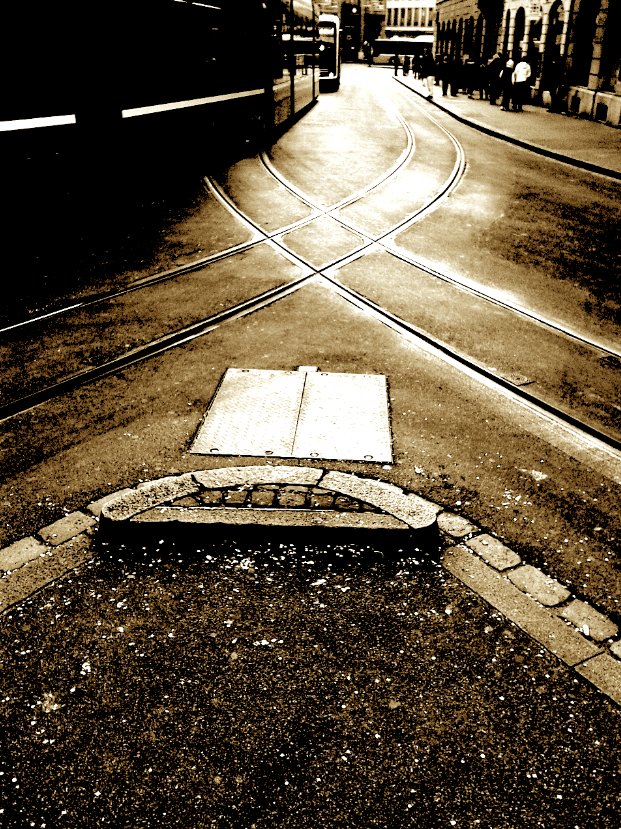
Towards the ›Fish Market‹ (picture: DS)
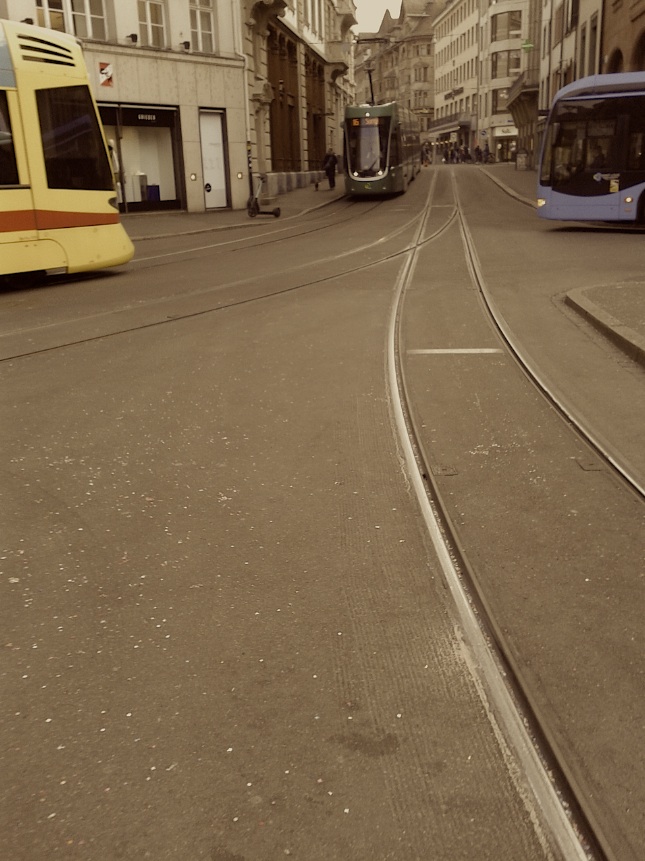
Basic Colors of a City (picture: DS)
3) Playing Traffic
At the time Picasso recalled that, once, at Basel, he had been watching the traffic of tramways, and that he had stayed up all night to see the traffic start in the next morning (he recalled that while speaking with Ernst Beyeler, and also while speaking with Werner Spies), the Swiss board game manufacturer Carlit had already published a board game classic which is called Traffic (see my photo of a box which, accidentally, I saw in a second hand store today).
While talking to Ernst Beyeler Picasso recalled more detail, but Werner Spies describes Picasso, living in Mougins nearby Cannes in the 1960s and early 1970s, watching the traffic on the highway nearby, which makes a sort of landscape scene, but a landscape with the element of passing time, flowing, continuously into the future, with cars indicating the flow (Spies 2012, p. 415).

(Picture: Guy Lebègue)
»1962 war Picasso nach Mougins gezogen, in einen Ort auf halbem Weg zwischen Cannes und Grasse. Sein Haus liegt gut sichtbar über der Stadt, und man erkennt es deutlich, wenn man sich auf einer kleinen Strasse am Fuss des Hügels dem weitläufigen Mougins nähert. Einige hundert Meter weiter, dem Meer und Cannes zu gelegen, verläuft eine Autobahn, die man vom Haus aus genau sehen konnte. Picasso liebte, wie er erzählte, das Hin und Her der flitzenden Autos: ›In Basel im ›Trois Rois‹ habe ich von meinem Hotelzimmer aus den Strassenbahnen zugeschaut. Ich blieb am Fenster, bis der Verkehr nachts aufhörte. Da man mir gesagt hatte, es würde frühmorgens wieder losgehen, ging ich gar nicht ins Bett, sondern blieb die paar Stunden auf.‹ Oft hatte ich das Haus voller Sehnsucht von Ferne wie eine Gralsburg erspäht. Bis 2 Uhr in der Früh konnte man von der kleinen Strasse aus, die von der Autobahnausfahrt Cannes nach Grasse führte, oben im Hügel das Licht sehen, unter dem Picasso urbi et orbi seine Faunsköpfe, seine Atelierszenen, sein erotisches Marionettentheater zu Papier brachte. Die Vehemenz, mit der der Einsiedler an der Côte d’Azur die Zeit ausschöpfte, erschien beispiellos.«
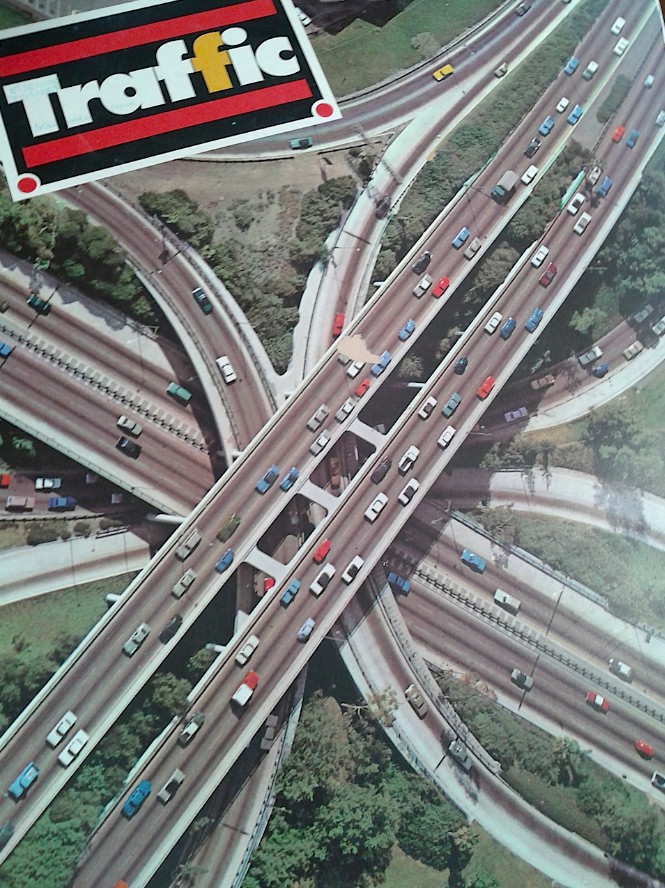
(Picture: DS)
4) Musing on Traffic – a Model Railway
I am fascinated that, in the very same second hand store where I photographed the board game, I also found two objects in a very telling, but somewhat surreal combination: a station clock was for sale here, not a Swiss one but a German one, and a model railway – without actual trains, but – with many lovely details (a tennis court, people waiting at a bus stop, even a small lake, and also a church with a graveyard):
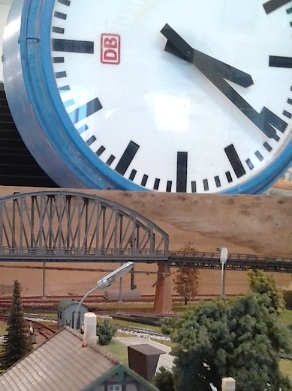
(Picture: DS)
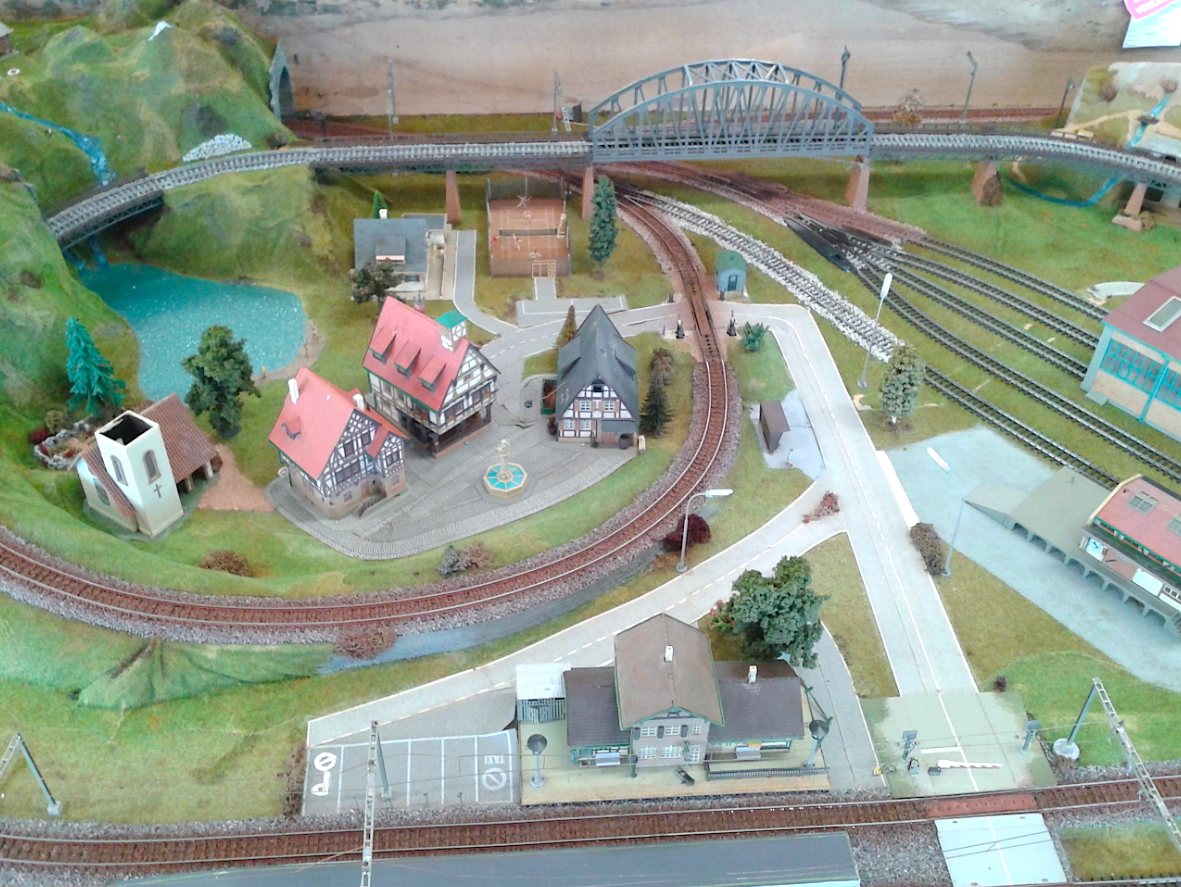
(Picture: DS)
And it is becoming more and more obvious that the main actor of our little visual essay is actually absent, and that it, the main protagonist, is time. While playing a game we may exist outside normal time and daily routine, and happiness might be associated with such state of being. Watching traffic might be a doing which could be situated somewhere between any distraction from daily routine and actual playing, and certainly it, the watching of traffic, is not daily routine. It is distraction (from normal time), perhaps also awareness of passing time, and it is being/existing in time, while not actually experiencing passing time painfully, but rather inhabiting it peacefully, feeling the various pulses of life, and not forgetting about it (which might be a condition for experiencing happiness). A model railway, if it is to be found in a second hand store, can be seen as an embodiment of all these aspects of watching traffic: it is an embodiment of playing, as it is reminding childhood and youth; it is an embodiment of contemplation (and can have even include figures contemplating something within the scenery), and perhaps it is also an embodiment of musing about time and passing time, and in the end it, the model railway, is a painful reminder that, for someone (who had loved it, living with it), time had passed, as well as it is a joyful reminder of time continuing flowing into the future, experienced painfully, perhaps nervously, but occasionally also happily, or at least peacefully – while watching traffic, and while life, felt intensely, still goes on.
5) Watching Traffic Nervously or Joyfully – User Statistics (2010-2015)
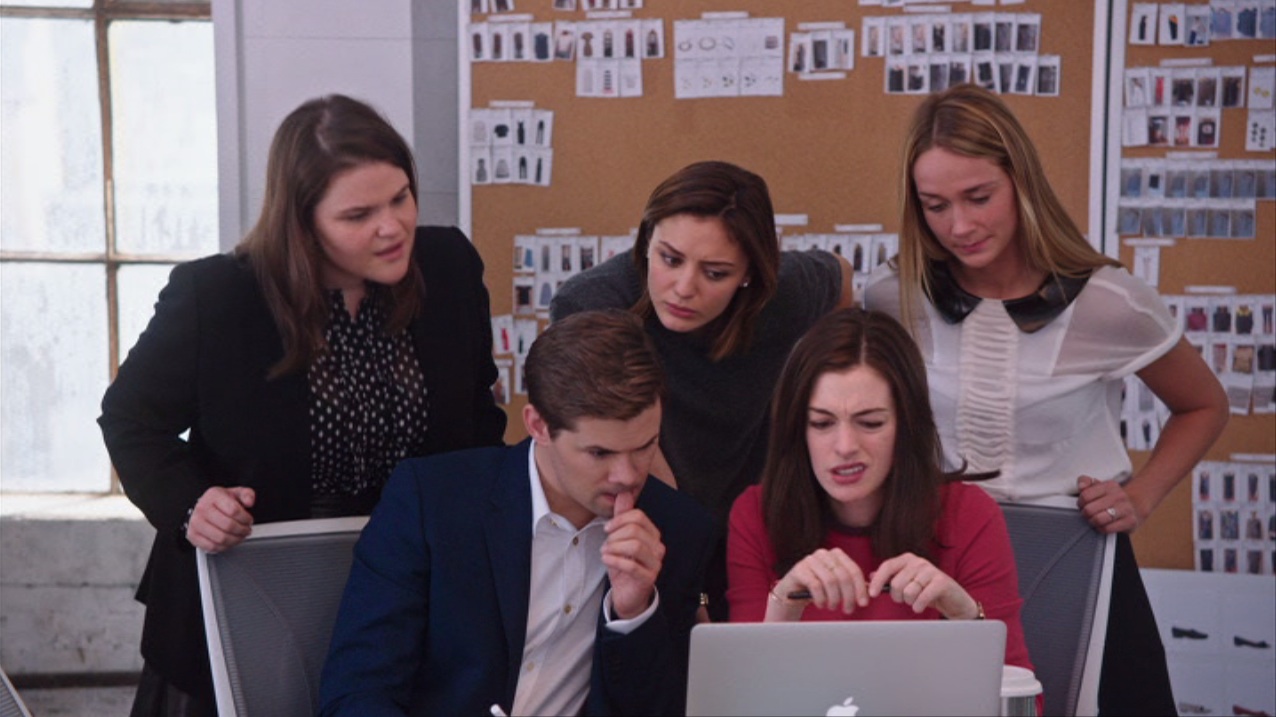
Still from The Intern (2015) (picture: DVD The Intern)
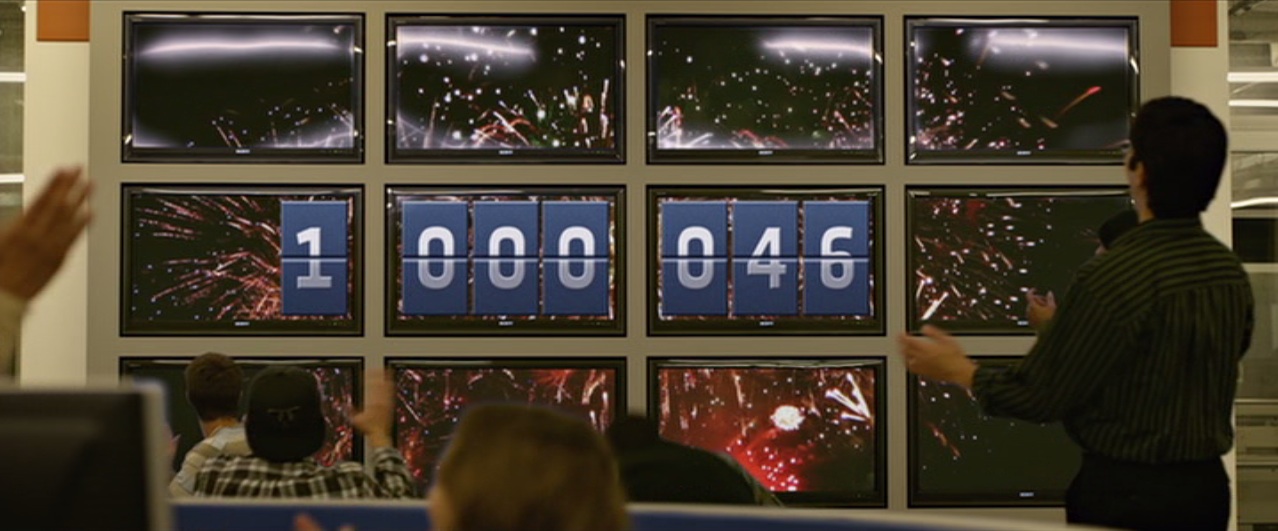
Still from The Social Network (2010) (picture: DVD The Social Network)
The principle of ›the more, the better‹ (or also: ›the less, the better‹, ›the more fluent, the better‹) is not compatible with watching traffic peacefully. But it can be linked with joyful emotions, if success (growth or also: degrowth) is experienced (and celebrated) in a team. Various movies display such iconography of watching traffic, which Picasso never got to know und probably would not have enjoyed. At least it is hard to imagine Picasso rejoicing due to his website being sucessfull according to numbers of visitors hitting his site or becoming members of his social network. The traffic being watched should not be linked to one’s projects and status in life, if to reach peace of mind should be a goal. It is a precondition that the traffic being watched is nothing but the given flow of things around an individual, into which the individual may immerse. And it is to be remembered that, what Picasso experienced at Basel was not only traffic, but a traffic itself being framed by, or immersed into the basic rhythm of day and night – while also a river was flowing, endlessly, continuously. Into the future.
Further Reading:
Marc Fehlmann / Toni Stoos (eds.), Picasso und die Schweiz, exh. cat. Kunstmuseum Bern, Bern 2001 [with memoir of Erns Beyeler, p. 121ff.];
Werner Spies, Mein Glück. Erinnerungen, Munich 2012 [with Picasso recalling having watched traffic at Basel, p. 415]
MICROSTORY OF ART
ONLINE JOURNAL FOR ART, CONNOISSEURSHIP AND CULTURAL JOURNALISM
HOME
© DS
